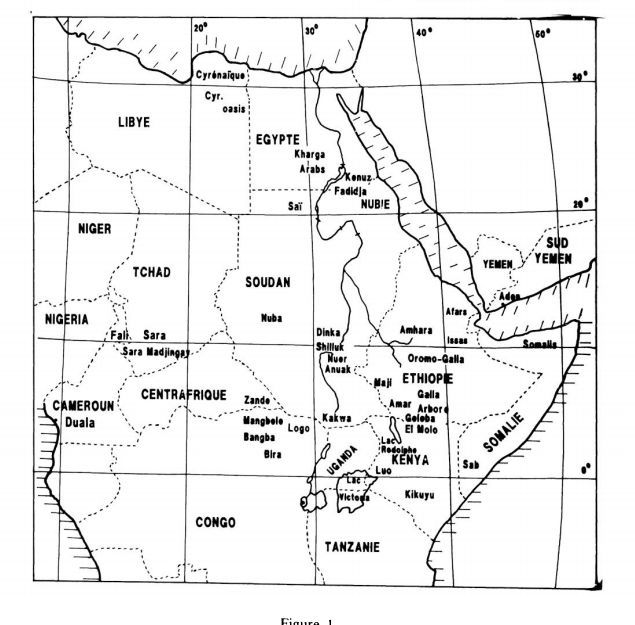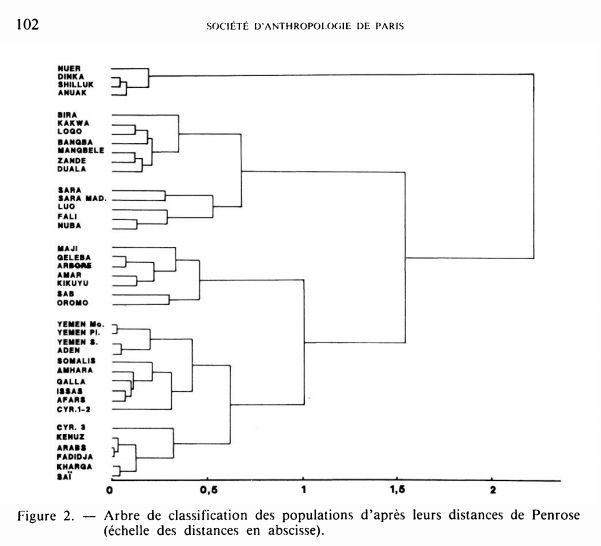As can be seen, the northern Horn groups in general, including the northern Somalis, form an immediate cluster with the Yemeni and coastal Libyan samples, before ultimately tying up with the other North African and Southwest Asian groups. A central Oromo sample and the southern Somali/Sab sample, on the other hand, cluster with Afro-Asiatic-speaking groups in southern Ethiopia that have a very large, dominant Sub-Saharan component (such as the Geleba/Daasanach and the Maji/Dizi); the Kikuyu sample also belongs to this cluster due to some admixture with neighboring Cushitic groups (per Wood et al. (2005), about 19% of them are E1b1b carriers).
This divergent clustering pattern on the part of the Oromo sample and the Sab is attributable to the fact that many modern Oromo speakers actually belong to other, non-Oromo ethnic groups that the Oromos assimilated (mainly Omotic groups), and the Sab are heavily admixed with Sub-Saharan peoples (so much so that one major publication on Somalia actually suggests that they are of Bantu origin and were later assimilated into the dominant Somali culture).
This divergent clustering pattern on the part of the Oromo sample and the Sab is attributable to the fact that many modern Oromo speakers actually belong to other, non-Oromo ethnic groups that the Oromos assimilated (mainly Omotic groups), and the Sab are heavily admixed with Sub-Saharan peoples (so much so that one major publication on Somalia actually suggests that they are of Bantu origin and were later assimilated into the dominant Somali culture).
"The Somali nation comprises two main subdivisions, the 'Soomaali' and the 'Sab'. The Sab tribes form an extensive wedge of cultivators between the rivers of Somalia and separate the nomads of northern Somaliland from those of the south. The 'Soomaali', who are numerically superior, despise the 'Sab' for their sedentary way of life, for their mixed origins (Oromo and Negroid admixture is pronounced), and for their mixed genealogies. Nevertheless, Sab are included in the designation 'Soomaali' by outsiders, in much the same way as the inhabitants of the British Isles are frequently indiscriminately referred to as 'English'. Within the Somali nation, Soomaali and Sab are differentiated although there is an increasing tendency for the Soomaali/Sab cleavage to be ignored in the rising tide of Somali nationalism. Urbanized and Westernized Somali maintain that discrimination is 'old-fashioned', that it is contrary to the injunctions of the Prophet, and that it undermines the unity of the Somali people. In practice and actual social relations, however, these ideals are often betrayed, which serves to indicate how deeply engrained the traditional Somali social order is."-- Akbar S. Ahmed, David M. Hart, Islam in tribal societies: from the Atlas to the Indus, p. 129
"Somalis are comprised of two major groups: the dominant Samaale (75 per cent of the population) and the Sab (20 per cent). There exists some controversy over whether the Sab have been fully incorporated as Somalis for they have traditionally been distinguished as sedentary or semi-sedentary agriculturalists inhabiting the interriverine area, while the Samaale are pastoral nomads. The Samaale are believed to be Hamitic in origin whereas the Sab are Bantu, migrants from the equatorial lakes of Africa. It is hypothesized that the Samaale have inhabited the Horn for at least 1,000 years, driving out or subjugating the populations of the interriverine areas as slaves. However, much of the literature maintains that the two groups have been integrated through intermarriage and that they are now considered as one. Recent studies by archaeologists will provide information that may alter much traditional thought on this subject."-- Mark DeLancey, Somalia, p. xiii

